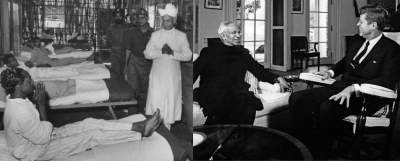The country’s second President, Dr Sarvepalli Radhakrishnan, is remembered mainly on his birthday, September 5, which is celebrated as Teachers’ Day in honour of his impeccable career as an educationist and his belief that “teachers should be the best minds in the country”.
His services to the country, though, were not confined to education. Laying the foundation of strong relations with the Soviet Union was one of his lasting contributions.
A man of many parts, Radhakrishnan (1888-1975) was not only an acclaimed teacher but also a distinguished philosopher and cultural ambassador and went on to prove to be an effective diplomat, and a consummate statesman.
His academic and philosophical achievements — as the first holder of the Spalding Chair of Eastern Philosophy and Ethics at Oxford (the first time an Indian held a chair at the university), his defence of Hinduism against “uninformed Western criticism” and his interpretation of it as a system of philosophy (and not just a religion of rituals) — are his everlasting contributions.
He was knighted in 1931, a title he abjured after Independence, but India aptly recognised him by making him one of the first three recipients of the Bharat Ratna when the nation’s highest civilian honour was instituted in 1954, the others being C. Rajagopalachari and Nobel laureate C.V. Raman.
But his academic and philosophic career was not all that he bequeathed to the country.
His tenure as President (1962-67), after two terms as Vice President since 1952, saw the deaths of two Prime Ministers, including one of the country’s most far-sighted founding fathers, and two of Independent India’s wars. His calming presence was reassuring as newborn India confronted the many challenges to its nationhood.
But most important to India, as the Cold War spread across the world, and in Asia too, was his role as India’s second Ambassador to Moscow (1949-52), where he not only laid the ground for a close relationship with the Soviet Union, but also managed to persuade it to unwaveringly support India on Kashmir — a commitment that survived the collapse of the Soviet Union.
Veteran diplomat Maharaja Krishna Rasgotra, in his memoir “A Life in Diplomacy” (2016), terms the decision to send Radhakrishnan to Moscow “(Prime Minister Jawaharlal) Nehru’s most imaginative choice for the post at that particular time”.
Rasgotra noted: “Stalin had to be convinced of the genuineness of India’s Independence, of the depth of India’s concern over Cold War tensions and its desire for peace and for Russia’s friendship and cooperation. The usual diplomatic approach would be of no avail, and Radhakrishnan was just the man for the complex task.”
As his “lean, tall figure and austere appearance made him look like a modern messiah”, Radhakrishnan intrigued Stalin so much that he was summoned to a meeting soon after he took over in Moscow (from Vijayalakshmi Pandit in 1949). He became one of the few people who the Soviet leader was happy to meet, not to mention one who often left him at a loss for words.
Citing Radhakrishnan’s deputy, Rajeshwar Dayal, who was also present at the meeting on January 15, 1950, Rasgotra says the philosopher-diplomat, ater answering Stalin’s probing questions — if India still had British army officers or a navy, or why Ceylon was not a part of it, and so on — deplored the Cold War and suggested that the Soviet Union should take the initiative to end it.
“When Stalin said that there was also another side responsible for it and it takes two hands to clap, the Ambassador’s solution to the problem left him without an answer: ‘As a peace-loving country, the Soviet Union should withdraw its own hand as it takes two hands to clap’.”
Radhakrishnan’s own account, sent in a telegram (CCB No. 397) to Foreign Secretary K.P.S. Menon, went on to mention: “Interview was pleasant and lasted half an hour. PAVLOV, Head of North Europe Division of Soviet Foreign Office and former Counsellor in London, acted as interpreter. Stalin smoked cigarettes continuously and LAUGHED occasionally. Appeared in quite good health and was alert and attentive. Interview took place in a pleasant and relaxed atmosphere.”
Soviet support to India on Kashmir owed to Radhakrishnan’s “informality and directness”, Rasgotra noted in his memoirs.
“In a meeting with Foreign Minister Andrey Yanuarevich Vyshinsky, the Ambassador suddenly asked him why Russia was not supporting India on the Kashmir issue in the Security Council. Taken by surprise by this unanticipated query on an important foreign policy issue, Vyshinsky mumbled something about India never having asked for Soviet help in the matter. ‘But that’s what I am doing now, am I not?’ “
And from the very next Security Council meeting in 1951, where the “Soviet Union’s representative blasted the UK and USA for meddling in Kashmir’s internal affairs”, the Soviet Union began vetoing Western resolutions, unacceptable to India, and “all this took place on the ambassador’s own initiative, without consulting with anyone in India”. Even Nehru was taken by surprise.
When he was due to return to India, to become Vice President, Radhakrishnan was again received by Stalin, who assured India of all help.
“Both you and Mr. Nehru are persons whom we do not consider to be our enemies. This will continue to be our policy and you can count on our help,” he said. Stalin also ordered the recall of a Soviet correspondent in New Delhi against whom the Indian government had complained.
Radhakrishnan’s successor in Moscow, Menon, who went on to meet Stalin in February 1953, shortly before his death, noted that Stalin had, in the last five years, only received three Ambassadors — Radhakrishnan (twice), and those of France and Argentina.
As President, Radhakrishnan was the voice of reassurance that calmed the nation when the Chinese invasion of 1962 and the calamitous Indian reverses shook the people, after the death of Nehru in 1964, and the 1965 war with Pakistan, but his biggest achievement was to cool down tempers in the wake of the anti-Hindi agitation in 1965.
He prevented an irreparable regional breach when agitations swept Tamil Nadu against Hindi replacing English and Union Ministers C. Subramaniam and O.V. Alagesan, both of whom hailed from the state, resigned. His refusal to accept Prime Minister Lal Bahadur Shastri’s recommendation that their resignations be accepted led the latter to back down and make a compromise.
It was Radhakrishnan who also convinced an unwilling Shastri to retain the ministers, as several observers have noted, including M.J. Akbar in “India Besieged”.
He, however, remained a one-term President, with Prime Minister Indira Gandhi not keen on a second term for him. How would another term in Rashtrapati Bhavan have worked out for him — and Mrs Gandhi and India — will remain a conjecture.

